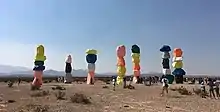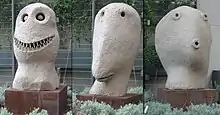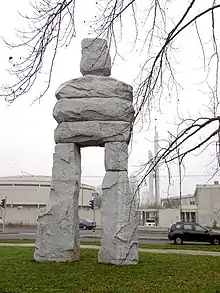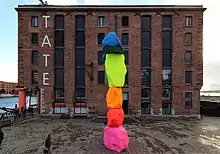Ugo Rondinone
Ugo Rondinone (born November 30, 1963) is a Swiss-born artist widely recognized for his mastery of several different media—most prominently sculpture, drawing and painting, but also photography, architecture, video and sound installation—in the largely figurative works he has made for exhibitions in galleries, museums and outdoor public spaces around the world. He has never limited himself to a particular material, no more than he has to a single discipline. Lead, wood, wax, bronze, stained glass, ink, paint, soil and stone are all tools in a creative arsenal that the artist has employed to extend the Romantic tradition in works that are as sensitive to the passage of time as to the nuances of body language and the spoken word.
Ugo Rondinone | |
|---|---|
| Born | Ugo Rondinone November 30, 1964 Brunnen, Switzerland. |
| Nationality | Swiss |
| Education | Hochschule für Angewandte Kunst, Vienna |
| Known for | Artist |
Notable work | Human Nature (2013) Seven Magic Mountains (2016) |
| Spouse(s) | |
| Website | ugorondinone |




Rondinone is widely known for his temporary, large-scale land art sculpture, Seven Magic Mountains (2016–2021), with its seven fluorescently-painted totems of large, car-size stones stacked 32 feet (9.8 m) high. [1]
Early life and education
Ugo Rondinone was born in 1964 to Italian parents in the resort town of Brunnen, Switzerland. He moved to Zurich in 1983 to become the assistant to Hermann Nitsch and studied at the Hochschule für angewandte Kunst in Wien, from 1986 to 1990. In 1998 he moved to New York City, where he continues to live and work.
Career
Rondinone emerged as an artist in the 1990s.[2] His paintings are noted for their brightly colored, concentric rings of target-shapes;[3] and strictly black and white landscapes of gnarled trees.[4]
Since 1997, Rondinone has included the practice of making signs in his varied oeuvre; he takes phrases from pop songs and everyday exclamations and makes them into rainbow-hued, neon-lit sculptures, including Hell, Yes (2001).[5][6] Another series of installations, Clockwork for Oracles (2008-2010) consists of mirrored works that are hung salon-style over a wall of pages from the local paper sourced at the time of installation.[7]
Rondinone later created a series that includes bronze-cast birds (primitive, 2011), horses (primal, 2013) and fish (primordial, 2018).[8]
Rondinone’s totem-like figures have been installed all over the world, from the Jardin des Tuileries in Paris (2009) to the Yokohama Triennale (2011).[9] In 2013 he exhibited an installation called Human Nature at Rockefeller Center, a group of nine monumental figures made of rough-hewn slabs of bluestone from a quarry in Northern Pennsylvania, resembling rudimentary rock totems.[10][11] Similarly, Soul (2013) is a group of 37 figures from bluestone found in upstate New York, ranging from just under 3 feet to nearly 7 feet tall.[12] Another sculptural installation, Vocabulary of Solitude (2016), involves 45 sculptures of clowns named after and positioned doing everyday tasks such as ‘wake, sit, walk and shower’.[13]
Early Works
If one refers to the official index of Ugo Rondinone's works, his corpus originates with a series of sculptures of flowers in plaster and Vaseline dated 1988. The artist commonly starts his trajectory, however, with landscapes drawn in India ink, in a style reminiscent of both seventeenth-century Dutch art and German Romanticism. Based on preparatory drawings he made during country walks outside of Vienna, these nostalgic landscapes introduced a number of elements that can also be found in his later works: a protocol leading him to create artworks based on handmade “studies” that, via several “transports” or transfers potentially incorporating steps delegated to independent contractors, result in another image; an attraction to variations on a single theme; the use of “cycles” and “systems,” in particular those conveyed by nomenclature in the titles he attributes to his works; and last, the creation of work pertaining to his autobiography. Those early landscapes were, in fact, made in response to loss, the artist’s partner, Manfred Kirchner, having died of AIDS in 1988. “In the midst of the AIDS crisis,” Rondinone recalls, “I turned away from my grief and found a spiritual guard rail in nature, a place for comfort, regeneration and inspiration. In nature, you enter a space where the sacred and the profane, the mystical and the secular vibrate against one another.”[1] The first landscape was painted on February 23, 1989. Rondinone would show three others, produced in March, June and October respectively, in an exhibition at the Kunstmuseum Luzern in Switzerland that same year, in which his approach to presentation might be considered the matrix of his exhibitions to come.[14]
An Art of Exhibition
One cannot dissociate Rondinone’s exhibitions from his works, which as a result evolve in forms of presentation that are ceaselessly reinvented by the artist. As with the way in which his works are subject to variations, he modifies the way their “content” and “container” are shown from one exhibition to the next. These modifications can be infinitesimal or can, on the contrary, involve profound changes. They can open up new perspectives or displace them. And they can involve the elaboration of a “scenario” so that for each presentation, the work or works can be seen as if never shown before. Exhibitions are also a way for the artist to play on vectors that are complementary, if not contradictory; a work shown by Rondinone in a specific context is often juxtaposed with “opposite” proposals. This can be seen with his landscapes. In the 1989 exhibition, his India ink drawings were arranged in a “homogeneous” manner, while a second exhibition, held in the same location a year later and devoted to his 1990 landscapes, presented them next to a temporary wall made of wooden slats painted in white. An extension of the gallery entrance, this wall isolated the exhibition system from the space’s facade and dissociated it from its “daily life,” creating a sort of corridor whose confined quality—conducive to spiritual and introspective contemplation—offered a powerful contrast with the openness to the world and nature suggested by the landscapes. The first “wall” imagined by Rondinone, it permitted him to invite a new “protagonist” or “figure” into a work for which the exhibition space would be the preferred stage and setting.
After his first exhibition at the Galerie Walcheturm in Zurich in 1991, in which he perpetuated the “narrative” of the Kunstmuseum Luzern and emphasized the “duality” formed by landscapes open to the world and a space cut off from it, in 1992, Rondinone unveiled a family of works that was resolutely other—his sun paintings. Related in their own way to spiritual withdrawal and “mindless activity,” these paintings are considered by the artist as a continuation of the landscapes, except, of course, for the fact that they replace the “figurative” drawings in black and white with a chromatic spectrum that is as iridescent and hypnotic as it is “abstract.” Distant. A sort of diurnal counterpart to the nocturnal scenes, reflecting once again the law of contrasts that is so prominent in Rondinone’s work.
Seven Magic Mountains (2016–21)
Seven Magic Mountains, commissioned, produced and financed by the Art Production Fund (APF) and the Nevada Museum of Art, followed Rondinone's work Human Nature, a Public Art Fund project of monumental, stone stick-figures arranged in the highly man-made environment of Rockefeller Center in Manhattan—and depicts the opposite: highly artificial neon totems set in the natural environment.[1]
The piece consists of 33 limestone boulders, each weighing 10 to 25 tons, arranged in seven towers 30 to 35 feet tall[15]—secured by a solid backbone, with each stone painted a bright, fluorescent color.[1] Approximately five years in the making, the work is located on the far southern end of Las Vegas Boulevard,[16] 10 miles south of the intersection of Las Vegas Boulevard and St. Rose Parkway in Henderson, Nevada, near Dry Jean Lake, with a backdrop of the McCullough Mountains.[17] It is located at 35°50′18.19″N 115°16′15.304″W.
The sculpture was organized by the Nevada Museum of Art[1] and runs from May 11, 2016 to December 31, 2018[16]—having originally been scheduled for two years and extended through the end of 2018.[15] Near the end of 2018, the sculpture was again rescheduled to extend three more years. The original installation opened following a two-day inaugural event.[18]
The work is situated on three acres (1.2 ha) of federally owned land[17] under the jurisdiction of the Bureau of Land Management.[17] Resolving federal, state, and local regulations consumed nearly 20% of the project’s budget[17] and permitting took approximately three years.[17] Ultimately, the Bureau of Land Management granted a “site” type right-of-way permit—typically a 30-year permit authorizing projects such as communication towers—for three years.[17] Seven Magic Mountains was privately funded and cost approximately $3.5 million.[15]
A special law reduces the producers’ and the artist’s liability if a member of the viewing public "does something stupid" (e.g., climbing and falling).[1] The law, Seven Magic Mountains, NRS 41.517, is the only public-art carve-out in the country.[17] Signs around the sculpture warn viewers of potential dangers.[1]
The Reno Gazette-Journal estimated that more than two million people have taken photographs at the sculpture for Instagram. Vogue used the installation in a photo shoot in April 2017.[15] It is one of the largest land-based art installations in the United States since the early 1990s.[16]
A similar sculpture, the 35 ft Miami Mountain, built in 2015, is located outside The Bass Art Museum in Collins Park, Miami Beach, Fl, as of December 2021.[19]
Exhibitions
Rondinone has had major solo exhibitions at Goulandris Museum of Cycladic Art in Athens (2012), Museo de Arte Contemporáneo de Castilla y León (2009), at Whitechapel Gallery in London (2006), Le Consortium in Dijon (2004), Centre Pompidou in Paris and Museum of Contemporary Art Australia in Sydney (2003), Kunsthalle Wien in Vienna (2002), and MoMA PS1 in New York (2000). In 2007 he represented Switzerland in the 52nd Venice Biennial (with Urs Fischer) and curated “The Third Mind” at Palais de Tokyo in Paris. Rondinone’s neon sculpture Hell, Yes! (2001) was installed on the New Museum’s façade from its opening in 2007 through 2010.[20]
Art market
Rondinone is represented by Esther Schipper, Galerie Eva Presenhuber (Zurich, New York),[21] Sadie Coles HQ (London),[22] Galerie Kamel Mennour (Paris), Kukje Gallery (Seoul), Krobath (Vienna)
and Gladstone Gallery (New York, Brussels).[23] His work resides in numerous public and private collections, including the Centre Georges Pompidou (Paris), the Albertina Museum (Vienna), the Israel Museum (Jerusalem), the Dallas Museum of Art, the Carnegie Museum of Art (Pittsburgh, PA), the Kunsthaus Zurich, and the Art Gallery of New South Wales (Sydney, Australia), among many others.
Other activities
- Public Art Fund, Member of the Board (since 2014)[24]
Personal life
Until 2013, Rondinone maintained a storefront studio at 39 Great Jones Street in the NoHo neighborhood in Manhattan.[25][26] In 2011, he acquired the 20,000 sq ft (1,900 m2) former Mount Moriah Baptist Church at 2050 Fifth Avenue in Harlem for $2.8 million.[27][28] Since 2014, he has been operating a second studio at his holiday home on the North Fork of Long Island.[29] He also owns a property in Matera, Italy.[30]
Rondinone was married to the poet and performance artist John Giorno.[31][32] In 2017, he was diagnosed with high-grade bladder cancer.[33]
References
- Andrew Russeth (May 31, 2016). "This Magic Moment: Ugo Rondinone Places Seven Mountains in the Desert Outside Las Vegas". Art News.
- Ugo Rondinone Biography, New Media Encyclopedia, retrieved 04.04.2015
- Ugo Rondinone 'Post-History Painting', Pomeranz Collection
- Ugo Rondinone, 'Temporary Contemporary', Bass Museum of Art
- "Ugo Rondinone – Works – Gladstone Gallery". gladstonegallery.com. Gladstone Gallery. Retrieved 2 November 2018.
- Ugo Rondinone: Hell, Yes!, December 7, 2007 – November 12, 2010 New Museum.
- Gabriella Angeleti (July 29, 2016), Bass museum to fill expanded space with shows by Ugo Rondinone, Mika Rottenberg and Pascale Marthine Tayou The Art Newspaper.
- Ugo Rondinone: primordial, April 20 – May 28, 2016 Gladstone Gallery
- Ugo Rondinone: Nude, May 4 - October 15, 2012 Goulandris Museum of Cycladic Art.
- Ugo Rondinone: Human Nature, April 23 - July 7, 2013 Public Art Fund.
- Scobie, Ilka (9 May 2013). "Ugo Rondinone: Human Nature at Rockefeller Center – artcritical". artcritical. artcritical. Retrieved 2 November 2018.
- Roberta Smith (June 27, 2013), [Ugo Rondinone: ‘Soul’] New York Times.
- Gabriella Angeleti (July 29, 2016), Bass museum to fill expanded space with shows by Ugo Rondinone, Mika Rottenberg and Pascale Marthine Tayou The Art Newspaper.
- Verhagen, Erik (2021). nuns + monks. Berlin: DCV. p. 41. ISBN 978-3-96912-020-0.
- Dawn Cate (June 1, 2018). "'Seven Magic Mountains' near Las Vegas is an Instagram dream". The Tampa Bay Times.
- "ugo rondinone seven magic mountains". Nevadaart.org.
- Isaac Kaplan (Apr 14, 2017). "How Artistry, Bureaucracy, and Lobbying Combined to Create a $3.5 Million Public Sculpture in the Desert". Artsy.net.
- Rebecca Kleinman (May 11, 2016). "The Story Behind Las Vegas' 'Seven Magic Mountains' Desert Art". Art News.
- https://ugorondinone.com/exhibition/miami-mountain/
- Ugo Rondinone: Nude, May 4 - October 15, 2012 Goulandris Museum of Cycladic Art.
- Daniele Muscionico (June 12, 2017), Eva Presenhuber: Die Kunstkanzlerin Die Zeit.
- Gabriel Coxhead (February 3, 2006),Deep and full of non-meaning Financial Times.
- "Ugo Rondinone - Gladstone Gallery". www.gladstonegallery.com. Retrieved 2022-01-26.
- Dan Duray (November 24, 2014), Ugo Rondinone Joins Public Art Fund Board ARTnews.
- Dan Duray (January 2, 2013), Karma Heads to Great Jones Street New York Observer.
- Linda Yablonsky (December 29, 2014), Holy Moly W.
- Matt Chaban (November 9, 2011), Heavens Yes! Ugo Rondinone Buys Harlem Church New York Observer.
- Linda Yablonsky (December 29, 2014), Holy Moly W.
- Mayer Rus (November 9, 2018), Artist Ugo Rondinone and Poet John Giorno Craft a Placid Long Island Paradise Architectural Digest.
- Linda Yablonsky (December 29, 2014), Holy Moly W.
- Dan Duray (January 2, 2013), Karma Heads to Great Jones Street New York Observer.
- "John Giorno (1936–2019)". Artforum. October 12, 2019. Retrieved October 12, 2019.
- Ugo Rondinone, Yellow Red White Blue Mountain (2019) Sotheby's.
External links
- Ugo Rondinone Human Nature at Rockefeller Center organized by Public Art Fund
- Ugo Rondinone's 2005–06 sculptures in Pappajohn Sculpture Park, Greater Des Moines Public Art Foundation in Iowa
- Ugo Rondinone Extended Biog and Exhibition information
- Art review by Joseph Nechvatal of Ugo Rondinone's THE THIRD MIND at Le Palais de Tokyo, Paris
- 'if there were anywhere but desert, Wednesday' Kaldor Family Collection, Art Gallery of NSW
- Ugo Rondinone Artist Page at Sommer Contemporary Art Gallery Website